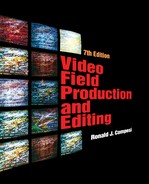Book Description
Video Field Production and Editing concentrates on video techniques and technology appropriate for "small scale" single-camera electronic field production (EFP) and electronic news gathering (ENG). This book offers the latest material on new digital field recording and editing technologies and is written in a concise, non-technical, user-friendly format. Reorganized and updated throughout, with new sections dedicated to HDV (High Definition Video) videotape recording formats, and tapeless digital recording media including high capacity optical discs, solid-state memory cards, and computer hard drives, the book walks the reader through the video production process from initial planning through final editing.
